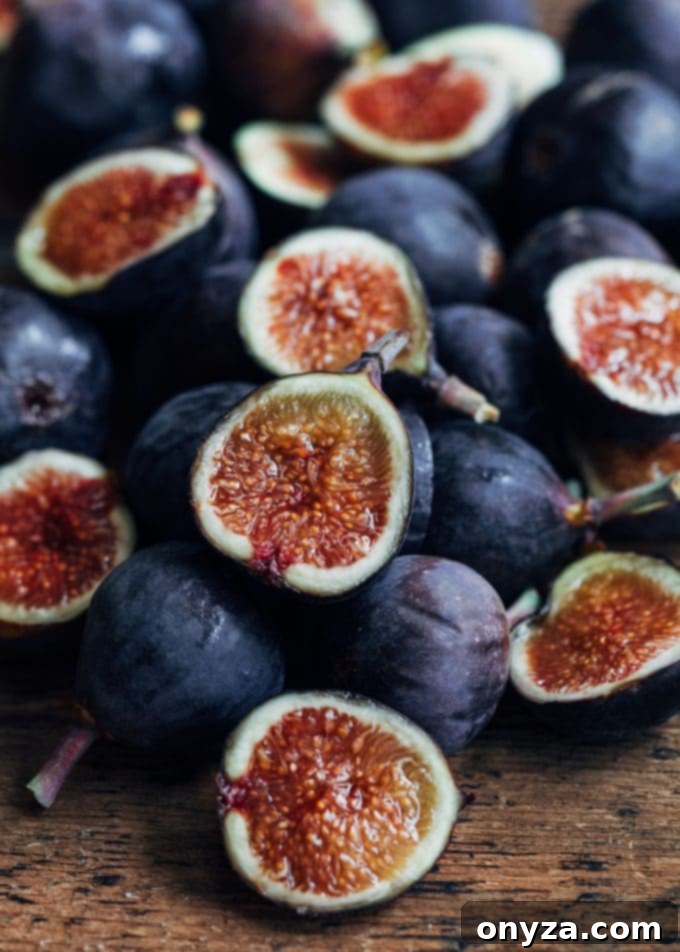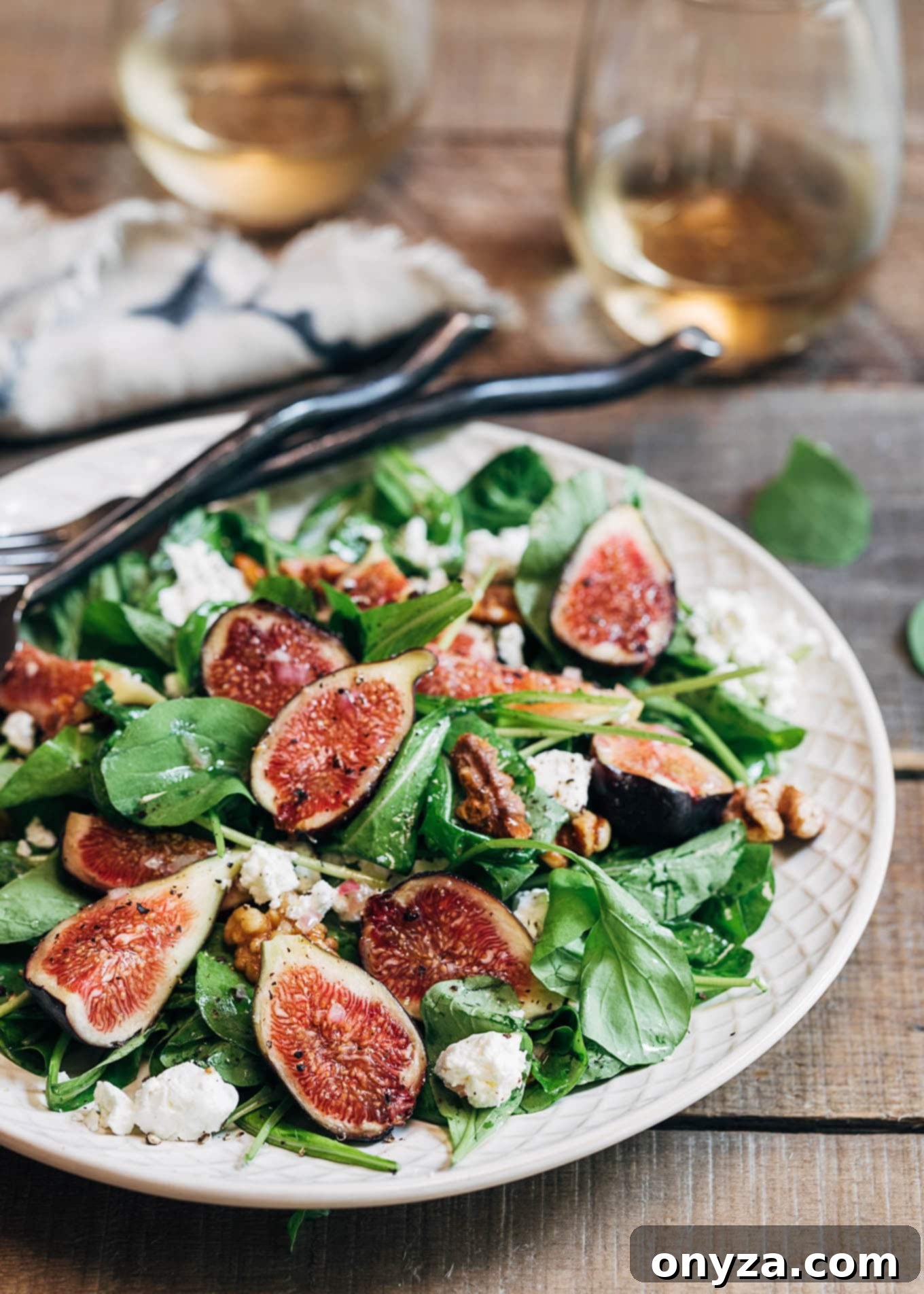This Fig Salad with Goat Cheese and Baby Arugula is a beautiful and elegant dish that’s perfect for a light lunch, a sophisticated starter, or a vibrant side dish. Prepare the individual components ahead of time and assemble just before serving for effortless entertaining.
This post contains affiliate links. As an Amazon Associate, I earn a commission (at no additional cost to you) from qualifying purchases made by clicking these links. As always, all recommendations and opinions expressed are my own.
Exquisite Fig Salad with Goat Cheese and Baby Arugula: A Seasonal Delight
Sometimes, the most exquisite dishes emerge from unexpected inspiration. I recall a morning when my culinary agenda was set, yet a visit to the local market unveiled an irresistible display of fresh, ripe figs. All plans were immediately set aside, as the allure of these seasonal treasures was simply too strong to resist. This spontaneous discovery led to the creation of one of my absolute favorite recipes: a vibrant Fig Salad with Goat Cheese and Baby Arugula. It’s an effortlessly elegant dish, ideal for late summer or early fall gatherings, offering a delightful blend of textures and flavors.
This salad brings together the peppery zest of fresh baby arugula, the delicate sweetness and juiciness of ripe figs, the creamy tang of crumbled goat cheese, and the satisfying crunch of toasted walnuts. All these elements are harmoniously united by a light and flavorful walnut oil-honey vinaigrette. The resulting symphony of tastes and sensations makes every bite a true culinary pleasure. It’s a testament to how simple, high-quality ingredients, when thoughtfully combined, can create something truly spectacular.
Why This Fig Salad Will Become Your New Favorite
What makes this fig salad so special and a must-try for anyone seeking a fresh, sophisticated dish? It’s all about the remarkable balance and contrast of its components. The inherent sweetness of fresh figs is beautifully complemented by the subtle tartness of goat cheese, while the peppery kick of baby arugula adds an exciting dimension. The toasted walnuts introduce a warm, earthy flavor and a much-needed crunch, preventing the salad from becoming one-note. Furthermore, the light walnut oil vinaigrette, with its delicate nutty notes and a hint of honey, ties everything together without overpowering the natural flavors of the produce.
This salad isn’t just delicious; it’s also incredibly versatile. It serves wonderfully as a standalone light lunch, a refreshing appetizer before a main course, or a vibrant side dish to complement grilled chicken or fish. Its elegant presentation makes it perfect for dinner parties and special occasions, yet its simplicity ensures it can be prepared quickly for a weeknight treat. The ability to prep most ingredients in advance further adds to its appeal, making entertaining a breeze.

Selecting the Perfect Figs for Your Salad
The success of this fig salad hinges significantly on the quality and ripeness of the figs. Figs are a seasonal fruit, typically available from late summer through early fall, though their exact season can vary by region and variety. When shopping, you might encounter several types, each with its own unique characteristics. The most common varieties found in local markets often include Black Mission, Brown Turkey, and Kadota figs. Understanding these varieties and how to select them is key to a truly delightful salad.
Popular Fig Varieties Explained
- Black Mission Figs: These are the dark-purple-skinned figs I used for this recipe. When perfectly ripe, Black Mission figs are exceptionally sweet, boasting a soft, juicy interior studded with numerous tiny, crunchy seeds. Their rich flavor and tender texture make them an ideal choice for pairing with creamy cheeses like goat cheese, creating a classic combination that stands out against the tangy and peppery elements of the arugula.
- Brown Turkey Figs: These figs feature reddish-purple skin and pinkish-brown flesh. They are generally less sweet than Black Missions but still offer a pleasant, mild sweetness and a soft, chewy texture. They work beautifully in salads and can add a slightly different flavor dynamic.
- Kadota Figs: Distinguished by their yellowish-green skin and amber-colored flesh, Kadota figs have a delicate, slightly nutty flavor and fewer seeds compared to other varieties. They are often used for preserves but are also excellent fresh in salads, offering a milder sweetness that allows other ingredients to shine.
- Calimyrna Figs: Recognizable by their light green to yellow skin, Calimyrna figs are known for their firm, chewy texture and a nutty, buttery flavor. They are delicious both fresh and dried, adding a different textural element to salads.
Tips for Choosing and Storing Fresh Figs
When selecting figs, remember that they are highly perishable and **do not ripen well once picked from the tree.** This makes careful selection at the market crucial. Look for figs that are soft to the touch but not mushy, with a slight give when gently pressed. Avoid figs that feel solid or hard, as these are underripe and will lack flavor. Conversely, steer clear of any that are excessively soft, bruised, or show signs of mold, as they are likely overripe and may have begun to spoil.
The skin of a ripe fig should also appear plump and intact. Slight wrinkles are acceptable and often indicate ripeness, but deep cracks or torn skin can suggest damage. A gentle, sweet aroma emanating from the figs is another excellent indicator of their readiness. Figs spoil very quickly, so it’s always best to **buy them as close as possible to when you plan to serve them.** Store fresh figs in a single layer in the refrigerator, ideally on a paper towel-lined plate, and aim to consume them within 1-2 days for the best flavor and texture.
Want to learn more about fig varieties? Check out, “6 Types of Figs to Try Right Now,” from Food Republic.

Crafting the Perfect Walnut Oil Vinaigrette
The vinaigrette is more than just a dressing; it’s the element that ties all the vibrant flavors of this fig salad together. My choice for this recipe is a simple yet incredibly flavorful walnut oil vinaigrette. Walnut oil, derived from pressed walnuts, is a truly special ingredient that brings a unique dimension to cold dishes and dressings. It’s renowned not only for its distinct warm, nutty flavor but also for its impressive health benefits, being rich in omega-3 fatty acids, antioxidants, and vitamins.
The Distinctive Qualities of Walnut Oil
The nutty character of walnut oil complements a wide variety of greens, especially the peppery notes of baby arugula, making it an ideal choice for this fig salad. However, it’s important to note its specific culinary applications. Unlike olive oil or canola oil, walnut oil has a low smoke point and a delicate flavor that can turn bitter when exposed to high heat. For this reason, I exclusively use it in vinaigrettes, finishing drizzles, and cold recipes, where its exquisite flavor can be fully appreciated and shine through without degradation. It’s not an oil for sautéing or frying.
Given its more specialized use and higher price point compared to everyday cooking oils, walnut oil is best used in smaller quantities where its flavor impact is significant. A little goes a long way in imparting a gourmet touch to your dishes. For those looking for quality, consider investing in a good cold-pressed walnut oil to experience its full aromatic profile. Store it in a cool, dark place, or even the refrigerator, to maintain its freshness and prevent rancidity.
Balancing Flavors: White Balsamic and Honey
For this particular vinaigrette, I’ve chosen white balsamic vinegar. Its fruity, less intense profile is perfect for complementing the sweet figs without the darker color or stronger acidity of traditional balsamic vinegar, which might overshadow the delicate hues and flavors of the salad. Combined with just a touch of honey, the dressing achieves a perfect balance of sweetness and tanginess. The minced shallot adds a subtle aromatic depth and a gentle bite, ensuring that the vinaigrette enhances each ingredient in the fig salad rather than dominating any of them.
Creating an emulsion for your vinaigrette is simple: start by whisking together the shallots, vinegar, honey, salt, and pepper. Then, slowly drizzle in the walnut oil while continuously whisking. This gradual addition helps the oil and vinegar combine into a stable, creamy dressing. Always taste and adjust seasonings; if you prefer a tangier dressing, a little extra white balsamic vinegar can be added to personal preference. This meticulous attention to the vinaigrette ensures a harmonious and unforgettable salad experience.
Assembling and Serving Your Elegant Fig Salad
One of the beauties of this fig salad is its potential for advanced preparation, making it a fantastic choice for entertaining. You can prep all the individual components—toasting the walnuts, mixing the vinaigrette, washing the arugula, and crumbling the goat cheese—well ahead of time. However, for the best possible texture and freshness, it’s crucial **not to assemble the salad until you are just ready to serve.**
Baby arugula, with its delicate leaves, can quickly wilt when dressed. To ensure your salad retains its vibrant crispness, I recommend tossing the arugula with the vinaigrette and plating it right as your guests are sitting down to the table. This timing ensures that every bite is as fresh and appealing as possible.
For optimal flavor distribution and a visually appealing presentation, I like to **lightly dress the baby arugula and toasted walnuts** with about half of the vinaigrette. Once arranged on a platter or individual plates, the fresh fig quarters are placed on top. A final light drizzle of the remaining vinaigrette over the figs, followed by a generous sprinkle of crumbled goat cheese, completes the masterpiece. If desired, a few grinds of freshly cracked black pepper and a pinch of flaky sea salt can enhance the flavors even further, adding a professional touch.
Perfect Pairings for Your Fig Salad
This simple yet sophisticated salad is best enjoyed immediately. It pairs wonderfully with a slice of warm, crusty bread to soak up any leftover dressing. To truly elevate the experience, I suggest serving it alongside a glass of **well-chilled Pinot Gris, a crisp Sauvignon Blanc, elegant champagne, or a dry brut Prosecco.** The bright acidity and effervescence of these wines beautifully complement the salad’s rich and complex flavors, creating a truly memorable dining moment. While it comes together quickly, this is the type of salad that invites you to slow down, savor each component, and appreciate the artistry of seasonal ingredients.
Elevate Your Fig Salad: Delicious Variations
While the classic Fig Salad with Goat Cheese and Baby Arugula is perfect as is, there are several ways to customize and enhance it, adding different layers of flavor and texture. Experimenting with these variations can transform the dish, making it suitable for various tastes or occasions.
Serving Variation: Crispy Prosciutto
For an extra layer of savory depth and a delightful crunch, consider topping this elegant salad with crisped prosciutto. The salty, savory notes of prosciutto create a fantastic counterpoint to the sweet figs and tangy goat cheese, elevating the entire dish to a gourmet level. Here’s how to prepare it:
- Preheat your oven to 350 degrees F (175 degrees C) with the oven rack positioned in the middle.
- Line a baking sheet with parchment paper or aluminum foil for easy cleanup.
- Arrange a few thin slices of prosciutto on the prepared baking sheet in a single layer, ensuring they don’t overlap too much.
- Bake for 10-15 minutes, or until the prosciutto begins to crisp up and turn a golden brown. Keep a close eye on it, as it can burn quickly.
- Once crispy, remove the prosciutto from the oven and transfer it to a wire rack to cool to room temperature. The prosciutto will continue to crisp as it cools, developing a delightful crunch.
- Break the cooled prosciutto into small pieces or crumbles and sprinkle it generously over the assembled salad just before serving.
Other Exciting Variations:
- Nutty Alternatives: While walnuts are classic, toasted pecans, pistachios, or even slivered almonds can offer different nuances to the salad’s texture and flavor profile.
- Cheese Swaps: If goat cheese isn’t your preference, try crumbled feta for a saltier tang, or a mild blue cheese for a bolder, more pungent flavor. Shaved Parmesan can also add a delightful umami touch.
- Herbaceous Touches: A light sprinkle of fresh mint, basil, or thyme leaves can introduce an aromatic freshness that complements the figs beautifully.
- Grain Boost: For a heartier salad that can serve as a full meal, consider adding a small amount of cooked and cooled quinoa or farro to the arugula base.
- Sweet Addition: A sprinkle of pomegranate seeds can add an extra burst of tart-sweetness and a beautiful ruby color, especially when figs are not quite at their peak sweetness.
More of Our Favorite Fig Recipes
- Fig Pizza with Gorgonzola, Balsamic Onions, and Prosciutto
- Fig Tart with Almond Cream
- Stuffed Figs with Cambozola, Walnuts, and Honey
- Baked Brie Bites with Figs and Prosciutto

Print Recipe
Fig Salad with Goat Cheese and Baby Arugula
Make the most of fig season with this simple and elegant salad recipe. For easy entertaining, prep the ingredients of this Fig Salad ahead and assemble just before serving.
Ingredients
- ½ cup walnut halves
Vinaigrette
- 1-1/2 teaspoons minced shallots (1/2 tablespoon)
- 1 to 1-1/2 tablespoons white balsamic vinegar
- 1 teaspoon honey
- ⅛ teaspoon kosher salt or fine sea salt
- ⅛ teaspoon freshly-ground black pepper
- 2 tablespoons walnut oil
Fig Salad
- 4 large fresh figs (or 8 small), I used Black Mission
- 5 cups baby arugula (5 oz package)
- 2 ounces goat cheese, crumbled
Instructions
Toast the Walnuts
- Preheat oven to 350 degrees F (175 degrees C). Spread walnuts into a single layer on a small baking sheet. Roast for 5-10 minutes until fragrant and toasted, stirring halfway through. Let cool while you prepare the vinaigrette.
Make the Vinaigrette
- In a small bowl, stir together shallots, 1 tablespoon vinegar, honey, salt, and pepper. Slowly drizzle in walnut oil, whisking, until emulsified.
- Taste the dressing. If you like it to have a more tart flavor, add an additional 1 to 1-1/2 teaspoons vinegar. Season to taste with additional salt and pepper.
Assemble the Fig Salad
- Cut stems from figs and slice in quarters if large and in half if small.
- Toss baby arugula with the toasted walnuts and half of the vinaigrette. Arrange figs on the top of the salad and lightly drizzle each with a little of the remaining vinaigrette. Sprinkle the salad with crumbled goat cheese.
- If desired, finish the salad with a few grinds of cracked black pepper and a few pinches of a medium-grind sea salt. Serve immediately.
Notes
Serving Variation: Crispy Prosciutto
For an extra layer of flavor and texture, this salad is also lovely topped with crisped prosciutto.
To make it, preheat your oven to 350 degrees F (175 degrees C) with the rack in the middle position. Line a baking sheet with parchment paper or foil.
Lay a few pieces of thinly-sliced prosciutto on the baking sheet in a single layer. Bake for 10-15 minutes, until prosciutto begins to crisp.
Remove from oven and transfer to a wire rack to cool to room temperature (prosciutto will continue to crisp as it cools). Break into small pieces or crumbles and sprinkle over the salad.
Nutrition Estimate
Carbohydrates: 17 g |
Protein: 6 g |
Fat: 19 g |
Saturated Fat: 3 g |
Cholesterol: 6 mg |
Sodium: 61 mg |
Potassium: 305 mg |
Fiber: 3 g |
Sugar: 13 g |
Vitamin A: 830 IU |
Vitamin C: 5 mg |
Calcium: 97 mg |
Iron: 1.3 mg
Nutrition information is automatically calculated, so should only be used as an approximation.
About Our Recipes
Please note that our recipes have been developed using the US Customary measurement system and have not been tested for high altitude/elevation cooking and baking.
We hope you enjoy this delightful fig salad as much as we do. Its blend of sweet, tangy, peppery, and nutty flavors makes it a perfect dish for any occasion. Don’t hesitate to experiment with the variations suggested to truly make it your own. Happy cooking!

